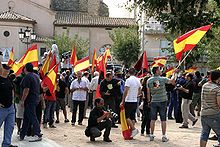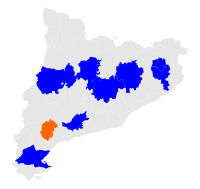Referendums on the independence of Catalonia 2009–2011
From September 13, 2009 until mid-2011, symbolic referendums on the independence of Catalonia were held in 553 of a total of 947 cities and municipalities in Catalonia . With a turnout of around 19 percent on average, the voters spoke in favor of Catalonia's independence from Spain. The results were in no way legally binding.
Historical background

After the reconquest of the Iberian Peninsula from the Moors , the Reconquista , four main kingdoms emerged: Castile , Portugal , Navarre and Aragon . The historical Kingdom of Aragon included Catalonia, today's autonomous communities of Valencia and Aragon, and the Balearic Islands . A Romance language of its own , Catalan , developed here. In 1469 Ferdinand , heir to the Crown of Aragon, married his cousin Isabella , heiress of Castile. They went down in history as the Catholic Kings ( Los Reyes Católicos ). Initially, however, this was only a personal union , so that the internal political independence of Catalonia was retained until it was eliminated after the War of the Spanish Succession in 1714 under the Bourbon King Philip V.
It was not until the Second Spanish Republic , which only existed from 1931 to 1936/39, that Catalonia was granted autonomous status. It got its own government, the Generalitat , and its own parliament. After General Franco's military coup , Catalonia sided with the Republicans in the Spanish Civil War and suffered severe reprisals after the victory of the Francoists . All traces of Catalan independence were suppressed and the use of the Catalan language was hindered. In the universities and schools, only Spanish (Castilian) was taught. Immigration from central Spain was encouraged.
After Franco's death and the gradual restoration of democratic conditions in Spain, Catalonia received the status of an autonomous community within Spain in 1978 . This Statute of Autonomy gives Catalonia extensive powers in the field of domestic policy. In 2006 the new version of the Statute of Autonomy was confirmed in a referendum in Catalonia. However, there were significant delays in the implementation of the provisions of this new Statute of Autonomy, as the autonomous communities or regions of the Balearic Islands, Valencia and Aragon and the Spanish opposition party Partido Popular (PP) brought an action before the Spanish Constitutional Court . The first three lawsuits related mainly to property rights to the Catalan cultural heritage, as well as water usage rights and the like, while the PP saw the unity of Spain in jeopardy in the Statute of Autonomy. By the end of 2009, the constitutional complaints had not been resolved. The delay in the implementation of the Statute of Autonomy led to dissatisfaction in Catalonia. It was also criticized that Catalonia, which is considered to be one of the “economic engines” of Spain (15% of the population of Spain live in Catalonia, but who generate 25% of industrial GDP ), takes a disproportionately large share in the financing of other parts of the country. In general, autonomy within Spain did not go far enough for the Catalan nationalists. They wanted a state of their own, Catalonia within the European Union , which should be completely independent from Spain.
Start and previous results of the referendums
The movement to hold independence referenda started from the Catalan community of Arenys de Munt . At the instigation of the anti-capitalist Candidatura d'Unitat Popular , the local government initiated a non-binding referendum. The question put to the voters was:
Està d'acord que Catalunya / la Nació Catalana esdevingui un estat de dret, independent, democràtic i social, integrat en la Unió Europea?
“Do you agree that Catalonia / the Catalan nation will become an independent democratic and social constitutional state in the European Union?”
In the vote in Arenys de Munt on September 13, 2009, 2,671 of the 6,500 eligible voters took part, which corresponded to a turnout of 41.1%. 2,569 (96.2%) voted yes and 61 (2.3%) voted no. This remarkably high level of approval encouraged Catalan independence advocates to launch similar campaigns in other Catalan communities as well. On December 12th and 13th, 2009, votes were held in a further 167 Catalan municipalities. Further days with a larger number of municipalities voting were February 28, 2010 (80 municipalities), April 24 and 25, 2010 (210 municipalities) and June 20, 2010 (48 municipalities). On April 10, 2011, the vote took place in the metropolis of Barcelona, where more than a fifth of the population of Catalonia live. 257,645 people took part in the vote, which corresponds to a participation of those entitled to vote of 21.4%. 230,590, corresponding to 89.5%, voted “Yes”, 22,626 (8.8%) voted “No”. By April 2011, votes had taken place in 533 municipalities. All residents - including foreigners - of the respective locations aged 16 and over were entitled to vote. A total of 883,911 of the 4,668,673 eligible voters (over 16 years of age) voted, which corresponded to a turnout of around 18.9%. 810,896 of those entitled to vote (91.7%) voted “Yes”, and 53,182 (6.0%) voted “No”. There was a clear majority in favor of the referendum in all voting communities. In the larger cities, voter turnout was mostly lower than in the rural communities (e.g. Lleida 8.2%, Tarragona 5.7%).
- Results of the referendums
Some of the total of 41 Catalan Comarques passed resolutions on the referendum: approval to implement refusal
Reactions and evaluation
The reactions to the referendums varied. The Catalan parties Esquerra Republicana de Catalunya and the Candidatures d'Unitat Popular were delighted with the high level of support for independence. Individual prominent politicians from the Convergència i Unió and the Iniciativa per Catalunya Verds also supported the referendum. There was also applause from the ranks of regional parties across Europe, such as the Welsh Plaid Cymru , the Scottish National Party , the Belgian Nieuw-Vlaamse Alliantie , the Corsican Partitu di a Nazione Corsa , the Irish Sinn Féin and others. Eight Catalan consell comarcal (roughly equivalent to the district council of a German district ) passed resolutions on the referendum. Seven agreed to the referendum ( Alt Camp , Bages , Baix Ebre , Gironès , Osona , Solsonès , Pla de l'Estany , Noguera ) one comarca ( priory ) rejected the referendum.
The referendum was clearly rejected by the "Citizens' Party" Ciutadans - Partit de la Ciutadania , the Partido Popular (PP) , the Unió Democràtica de Catalunya and a majority by the Socialist Party of Catalonia . The Spanish Prime Minister Zapatero criticized the referendum as not being constitutional and was criticized by the opposition PP for allowing this unconstitutional referendum to pass. In fact, there was no doubt that the referendums were not legally binding. According to the Spanish constitution, the unity of Spain is "indivisible". A constitutional amendment would be necessary for Catalonia's independence, which in turn required a two-thirds majority in both chambers of the Cortes Generales . In addition, the constitutional amendment would have to be confirmed by referendum throughout the country (not just in Catalonia). A referendum only at local or regional level is not provided for in the Spanish constitution. Nevertheless, the referendums were politically explosive. However, voter turnout was usually very low. In addition, the majority of the communities in which the Catalan nationalists were relatively strong were initially willing to hold the referendum.
More votes
Those in favor of the vote sought to hold referendums in other Catalan municipalities. Since April 10, 2011, however, no other Catalan municipality has been willing to hold the referendum. Since then, Catalan and all-Spanish politics have been increasingly determined by the national debt crisis and the general economic and financial crisis with the accompanying very high unemployment in Spain, so that Catalan regional policy took a back seat. In the parliamentary elections in Catalonia on November 5, 2012, there was also no decisive movement. The separatist party Esquerra Republicana de Catalunya gained significantly in votes, but the conservative Convergència i Unió , whose chairman Artur Mas had put on the nationalist card in the election campaign, lost just as significantly in votes.
On December 12, 2013, Prime Minister Artur Mas and representatives of the CiU, ERC, ICV-EUiA and CUP parties announced that they would hold a referendum on November 9, 2014 in Catalonia on the future political status of the region .
literature
- Krystyna Schreiber : The Translation of Independence. How the Catalans explain it, how we understand it . Verlag Fabian Hille, Dresden 2015, ISBN 978-3-939025-60-3
See also
Web links
- Catalonia dreams of independence and a vote with no concrete value , NZZ online, reports from December 11, 2009 and December 13, 2009
- Aufwind der Regions , article by Christoph Mayerl on eurotopics.net from August 6, 2007, accessed December 29, 2009
Individual evidence
- ↑ a b c d e f Consultes per la independència. Archived from the original on October 2, 2010 ; accessed on November 26, 2012 (Catalan, overall result and list of results of the voting municipalities).
- ↑ Admitidos los recursos de Aragón, Valencia y Baleares contra el Estatuto catalán , reporting Hoy.es
- ↑ Source: CIDEM , Why Catalonia? (pdf)
- ↑ On the ballot papers in Arenys de Munt there was talk of "Catalonia", on the ballot papers from 12./13. December 2009 then from the "Catalan Nation". This was important as Catalan is spoken outside of Catalonia (in the Valencia region , the Balearic Islands , parts of Aragon and Roussillon .)
- ↑ F. Espiga / L. Bou: Gràcia i Sarrià capitalitzen la mobilització sobiranista. Avui +, April 12, 2011, accessed April 14, 2011 (Spanish).







